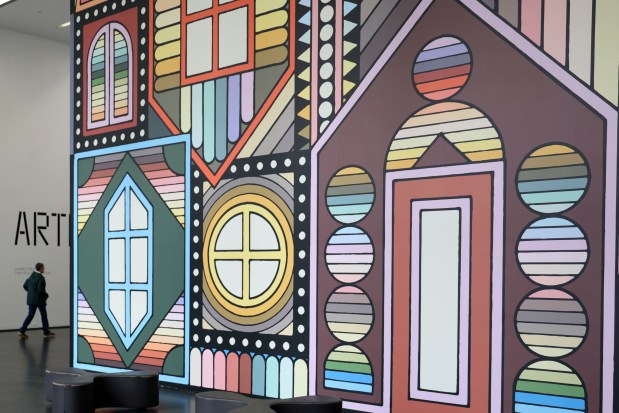The “Memory Palaces” of Edie Fake, exuberant, soft shimmering facades that glow like neon in the rain, paintings he likes to describe as comics, were largely about the past.
Or rather, some imagined Chicago past.
Fake, who once upon a time could be found behind the counter of Quimby’s in Wicker Park (until he left for California), was never one to be pinned down on anything. He worked as a tattoo artist and ran the comics department at Quimby’s. He cofounded the ongoing Chicago Alternative Comics Expo, and was the author of a long-running comic, “Gaylord Phoenix,” which offered nothing resembling a clear narrative. Since the trans artist’s gallery pieces tended to focus on Chicago’s queer community, the facades of his Memory Palaces were long-defunct queer bars and clubs and theaters and feminist spaces — Club LaRay, Nightgowns, the underground abortion clinic Jane Collective — reimagined.
Except when they weren’t.
I remember an interview with Fake in which he said people always want him to explain what he does and to make it a little clearer, and he just never feels like it. Recently, for instance, he installed a two-story mural in the atrium of the Museum of Contemporary Art Chicago; it’ll be there for exactly one year. It’s another Memory Palace of sorts, featuring the same pleasing stained-glass colors, art deco angularity and kaleidoscope of patterns. It reminds me of the buzzing, early-digital PBS commercials from the 1970s.
Except this Memory Palace is about an imagined future.
The title is “The Free Clinic for Gender Affirming Care,” and according to the MCA, it shows the front of a “utopian” clinic for transgender healthcare, “a majestic counterview to the present reality in the United States, where transgender and nonbinary people are under constant threat of political repression, restriction and scapegoating.” Unless, of course, you just look at the work, without reading the wall text. You might miss some of that.
“Actually, I feel like the wall piece is pretty blunt,” said Fake, who now lives in the desert outside Los Angeles. “I wanted there to be a sense of beauty and extravagance, for it to visualize this striking space as a place very much needed. But since you see the mural before the title, it is like comics in that it’s also a game of words and images, and how both interact can create a meaning. I just wanted to show things you can’t necessarily convey in words, and so the visuals in front of you, they’re like an amplifier of thoughts.”
The mural was made as an extension of an upcoming MCA exhibit, “City in a Garden: Queer Art and Activism in Chicago,” opening July 5. Assistant curator Jack Schneider sought out Fake for the museum’s ongoing Atrium Project series, which invites artists to redesign the large wall (beside the ticket sellers) in the building’s front entrance. “I also thought Edie would be a good artist to bring the political discussions in the exhibit up to date.” The result, Scheider said, is “something that’s unmistakably, distinctly Edie’s.”
Meaning, standing in front of the mural, this jumble of an ecstatic home, it’s hard not to see both the past and the future. I think of quilts and ‘80s vector-graphic video games; I see drug capsules and shutters from old homes; I see the crosscut port window of the “Amityville Horror” house, and animated cartoons sprinkled throughout “Sesame Street.”
I also saw, more importantly, warmth — a welcoming place.
Fake’s facades stem from “the way people make spaces together then a community happens, and falls apart, and reforms,” he said. “There’s a world-building aspect for me. It’s how I would like the world to be. I think it helps my mind to think of what that world might look like.” He saw the scale of the museum wall as “an opportunity for responding directly to such a tenuous time for trans healthcare and the need to do something now.”
Once he had the idea, it assembled quickly. And really, it only seems like a single building. If it existed, it would be a mash of places. As with his Chicago-born Memory Palaces, it suggests the way architecture get stacked over time, bundling old and new.
“But more dreamlike than Chicago,” he said.
The morning that the mural — which was hand-drawn to scale, then digitally recreated and printed onto a kind of large vinyl wallpaper — was finally ready for museum viewers, Schneider walked in and stopped before it. He hadn’t seen it finished yet, he said, admiring. It’s so different from the austerity of Chicago architecture, he said. So different from the blocky Brutalism of the museum itself. Manuel Venegas, the museum’s director of media relations, asked Schneider to explain the meaning behind the many windows and doors of this shanty town-esque fantasia.
Well, they’re actually large enough to pass through, he said. The front door there, albeit 2-D, is placed level with the museum floor. The windows are roughly the size of windows in a home.
“It’s like … an invitation,” Venegas said.
“It is an invitation,” Schneider said.
cborrelli@chicagotribune.com



